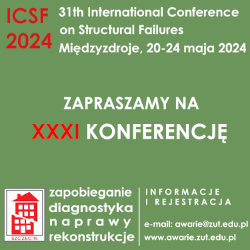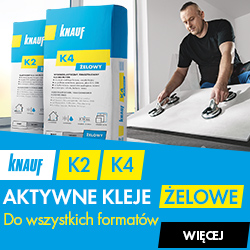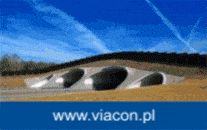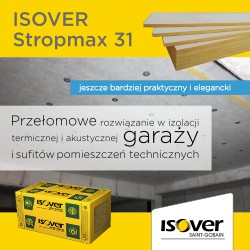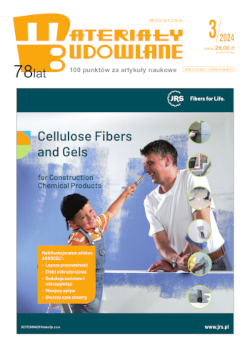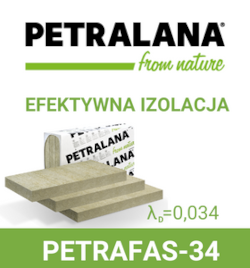dr inż. Artur Piekarczuk, Instytut Techniki Budowlanej; Zakład Konstrukcji Budowlanych, Geotechniki i Betonu, dr inż. Robert Cybulski, Politechnika Śląska; Wydział Budownictwa
Adres do korespondencji: Ten adres pocztowy jest chroniony przed spamowaniem. Aby go zobaczyć, konieczne jest włączenie w przeglądarce obsługi JavaScript.
DOI: 10.15199/33.2018.06.04
Streszczenie. Struktury łukowe z podwójnie giętych blach profilowanych systemu K-span obecnie stosowane są jako przekrycia obiektów użyteczności publicznej lub hale dla rolnictwa, a ich historia sięga niemal ośmiu dekad. Pomimo ciągłego rozwoju technologii wytwarzania systemu K span,metody projektowania nadal nie są spójne, co prowadzi niekiedy do powstawania groźnych w skutkach awarii i katastrof. Obecnie najefektywniejszą metodą obliczeń są symulacje komputerowe wspomagane badaniami, które w znacznej mierze przyspieszają proces projektowania, ale ich wykorzystanie może nastręczać problemów. W artykule przedstawiono w sposób przeglądowy podstawowe problemy w ocenie łukowych struktur podwójnie giętych oraz badawcze i analityczne podejście do ich rozwiązywania.
Słowa kluczowe: panele podwójnie gięte; system K-span; analizy numeryczne; badania.
***
Double corrugated self-supporting roofs panels
Abstract. Double corrugated arch structures of K-span system, are used as coverings of community facilities or farm buildings, and their history dates back to almost eight decades. Despite the continuous development ofK-span technology,methods of design are still not consistent, which sometimes leads to the emergence of dangerous failures and catastrophes. Currently the most effective calculationmethods are computer simulations supported by research,which significantly accelerate the design process, but their use may cause problems. The paper presents review of the basic problems in the assessment of arch double-curved structures as well as research and computational approach to solving design problems.
Keywords: double corrugated panels; K-span system; numerical analysis; research.
Literatura
[1] BiegusAntoni,AndrzejKowal. 2013. „Collapse of halls made from cold-formed steel sheets”. Engineering Failure Analysis 31 (lipiec): 189 – 94. DOI: 10.1016/j.engfailanal.2012.12.009.
[2] Cybulski Robert, Ryszard Walentyński, Monika Cybulska. 2014. „Local buckling of cold-formed elements used in arched building with geometrical imperfections”. Journal of Constructional Steel Research 96 (maj): 1 – 13. DOI: 10.1016/j.jcsr.2014.01.004.
[3] Decker J., C. Chiei. 2005. Quonset Hut: Metal Living for aModern Age. Zredagowane przez Chris Chiei & Julie Decker. New York: Princeton Architectural Press, 2005. DOI: 10.1007/1-56898-654-8.
[4] Malesa Marcin, Krzysztof Malowany, Jakub Pawlicki,Malgorzata Kujawinska, Pawel Skrzypczak, Artur Piekarczuk, Tomasz Lusa,Andrzej Zagorski. 2016. „Non-destructive testing of industrial structures with the use of multi-camera Digital Image Correlation method”. Engineering Failure Analysis 69 (listopad). Elsevier Ltd: 122–134. DOI: 10.1016/j.engfailanal.2016.02.002.
[5] Piekarczuk Artur, Krzysztof Malowany, Przemysław Więch, Małgorzata Kujawińska, Paweł Sulik. 2015. „Stability and bearing capacity of arch-shaped corrugated shell elements: Experimental and numerical study”. Bulletin of the Polish Academy of Sciences: Technical Sciences 63 (1): 113 – 123. DOI: 10.1515/bpasts-2015-0013.
[6] PiekarczukArtur,MarcinMalesa,Małgorzata Kujawińska, KrzysztofMalowany. 2012. „Application of hybrid FEM-DICmethod for assessment of low cost building structures”. Experimental Mechanics 52 (9). Springer US: 1297 – 1311. DOI:10.1007/s11340-012-9616-2.
[7] PiekarczukArtur, KrzysztofMalowany. 2016. „Comparative analysis of numerical models of arch-shaped steel sheet sections”. Archives of Civil and Mechanical Engineering 16 (4): 645 – 58. DOI: 10.1016/j.acme.2016.04.006.
[8] PiekarczukArtur, PrzemysławWięch, KrzysztofMalowany. 2017. „Numerical investigation into plastic hinge formation in arched corrugated thin-walled profiles”. Thin-Walled Structures 119: 13 – 21. DOI: 10.1016/j.tws.2017.05.029.
[9] PN-EN 1993-1-1:2006. Eurokod 3: Projektowanie konstrukcji stalowych – Część 1-1: Reguły ogólne i reguły dla budynków.
[10] PN-EN 1993-1-3:2008. Eurokod 3 – Projektowanie konstrukcji stalowych – Część 1-3: Reguły ogólne – Reguły uzupełniające dla konstrukcji z kształtownikówi blach profilowanych na zimno.
[11] PN-EN 1993-1-5:2008. Eurokod 3 – Projektowanie konstrukcji stalowych Część 1-5: Blachownice.
[12] PN-EN 1993-1-6:2009. Eurokod 3 – Projektowanie konstrukcji stalowych – Część 1-6: Wytrzymałość i stateczność konstrukcji powłokowych.
[13] Szewczak Ewa, Artur Piekarczuk. 2016. „Performance evaluation of the construction products as a research challenge. Small error – Big difference in assessment?” Bulletin of the Polish Academy of Sciences: Technical Sciences 64 (4). DOI: 10.1515/bpasts-2016-0077.
[14] Virdi K. S., F. K. Garas, J. L. Clarke, G. S. T. Armer. 1997. Structural Assessment. The role of large and full scale testing. Londyn. E&FNSpon.
[15] Walentynski Ryszard, Robert Cybulski, Rafael Sanchez. 2013. „Numerical stability analyses and preliminary experimental investigation of doubly corrugated steel arch panels”. Journal of the International Association for Shell and Spatial Structures 54 (175): 3 – 14.
[16]Walentyński Ryszard, Robert Cybulski. 2013. „Stability analyses and experimental investigation of doubly corrugated steel arch panels”. Architecture Civil Engineering Environment (4): 79 – 92.
[17] Walentyński Ryszard, Robert Cybulski, Krzysztof Kozieł. 2011. „Numerical models of ABM K-span steelarch panels”. Architecture Civil Engineering Environment 4 (4): 105–113.
[18] Walentyński Ryszard, Rafael Sanchez, Robert Cybulski. 2012. „Linear buckling analysis with differentABMK-span arch panels”. Architecture Civil Engineering Environment 5 (2): 79 – 86.
[19] Walentyński Ryszard, Robert Cybulski, Krzysztof Kozieł. 2011b. „Achilles” heel of the ABM 120 double corrugated profiles”. W New Trends in Statics and Dynamics of Buildings. Slovakia University of Technology in Bratislava, 25–28. Faculty of Civil Engineering STU Bratislava Slovak Society of Mechanics SA.
[20] Walentyński Ryszard, Robert Cybulski, Janusz Mazurkiewicz. 2013. „Doubly corrugated cold-formed arch roof panels. Advanced identification of geometrical and material properties”. Architecture Civil Engineering Environment 6 (1): 33 – 47.
Materiały Budowlane 06/2018, str. 18-21 (spis treści >>)











